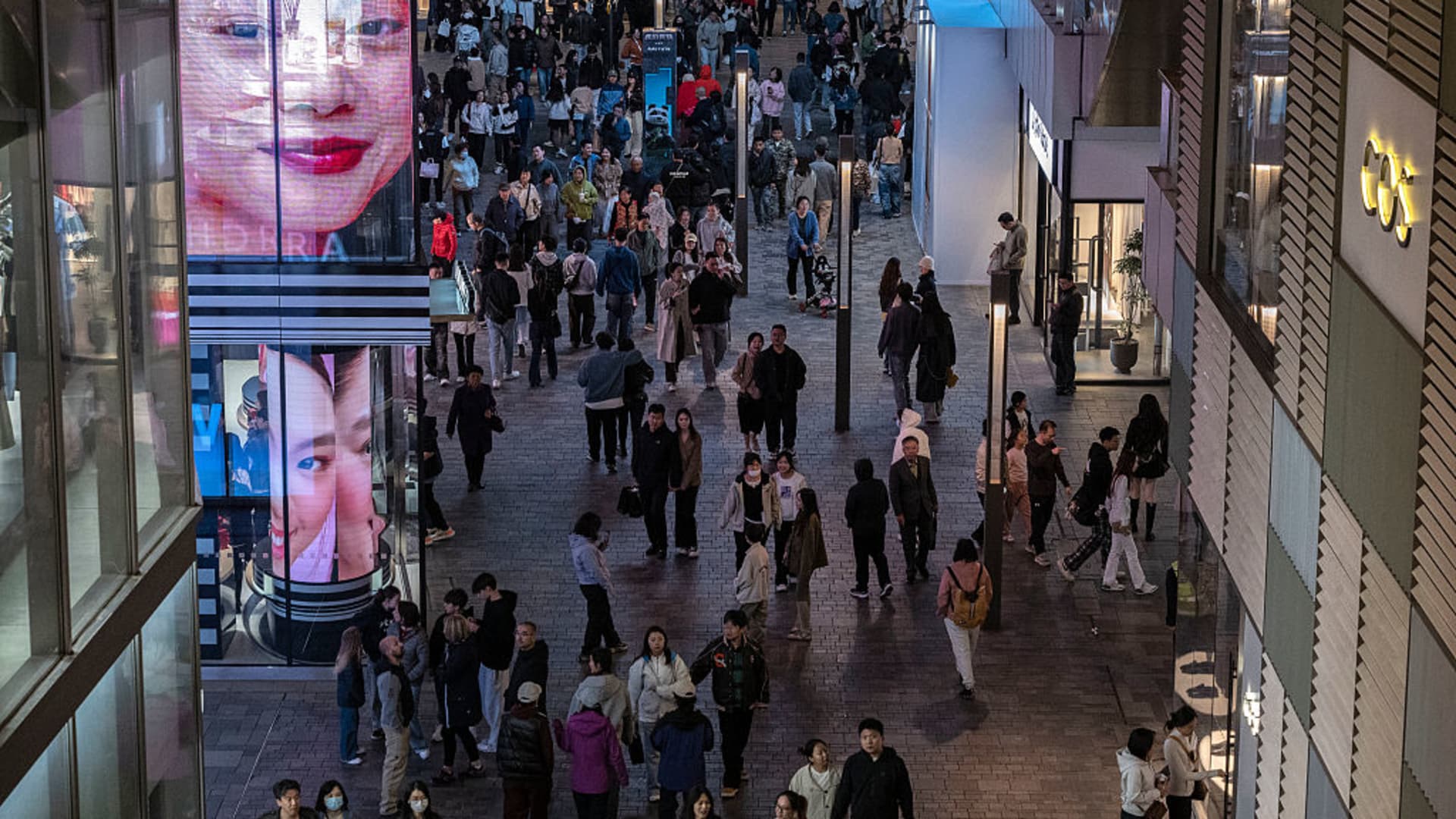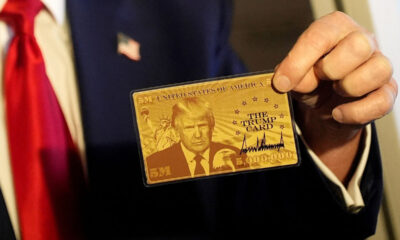Finance
Stocks making the biggest moves midday: LW, LEVI, W
Published
1 year agoon

Check out the companies making headlines in midday trading. Hertz Global — The car rental company shed about 4% after it was downgraded to sell from neutral at Goldman Sachs. Investors have yet to fully price in some near-term pressures, the bank wrote. Block — The financial services stock lost nearly 2% following a downgrade to underweight from equal-weight at Morgan Stanley. As reasons for the change, the firm cited “high market penetration and limited additional opportunity.” Zeta Global — The software stock added 17% after Morgan Stanley upgraded the software firm to an overweight rating from equal weight. The bank wrote that it expects positive revisions to valuation and estimates going forward, as evidence pointing to Zeta’s near-term catalysts and “strong track record” of prudent guidance. Wayfair — Shares of the home-focused e-commerce retailer added more than 3% following an Evercore ISI upgrade to an outperform rating from in line. The firm foresees Wayfair gaining market share as the home furnishing space recovers. Levi Strauss — The apparel company’s shares rallied 16% after it topped first-quarter expectations on the top and bottom lines and raised its profit guidance for the full year. Conagra Brands — The consumer packaged goods food company climbed 5% after exceeding analysts’ estimates for its fiscal third-quarter earnings and revenue. Conagra posted adjusted earnings of 69 cents per share on revenue of $3.03 billion, exceeding the 65 cents per share on revenue of $3.01 billion expected by FactSet. Lamb Weston — Shares plunged nearly 20% after the fries producer missed its third-quarter earnings and revenue. Lamb Weston posted third-quarter adjusted earnings of $1.20 per share, less than the $1.45 analysts polled by FactSet had expected. The firm’s revenue of $1.46 billion also came under the anticipated $1.65 billion. Alaska Air Group — The airline carrier gained 5%. Alaska said that it had received $160 million in compensation from Boeing after the grounding of the 737 Max 9. Grindr — The LGBTQ-focused dating app climbed 2.5% after Raymond James initiated coverage with an outperform rating. The firm said its sees several reasons to be optimistic on the stock, including its moat, consumer base and margins. HubSpot — Shares soared nearly 10% after Reuters reported that Alphabet was in talks to make an offer for the marketing software company. Alphabet has not yet submitted an offer for the deal. Solventum — The health-care stock rose 4.5%. Solventum was just spun off from 3M on Monday, with Thursday’s pop marking its first positive day since its debut. Solar stocks — Solar stocks rose higher during Thursday’s session as the yield on the benchmark 10-year Treasury moved lower. Enphase Energy rose 7%, while First Solar popped 6%. SolarEdge Technologies advanced more than 7%. — CNBC’s Alex Harring and Hakyung Kim contributed reporting.
You may like
Finance
Chinese factories stop production, eye new markets as U.S. tariffs hit
Published
5 hours agoon
April 27, 2025
Textile manufacturing workers in Binzhou, Shandong, China, on April 23, 2025.
Nurphoto | Nurphoto | Getty Images
BEIJING — Chinese manufacturers are pausing production and turning to new markets as the impact of U.S. tariffs sets in, according to companies and analysts.
The lost orders are also hitting jobs.
“I know several factories that have told half of their employees to go home for a few weeks and stopped most of their production,” said Cameron Johnson, Shanghai-based senior partner at consulting firm Tidalwave Solutions. He said factories making toys, sporting goods and low-cost Dollar Store-type goods are the most affected right now.
“While not large-scale yet, it is happening in the key [export] hubs of Yiwu and Dongguan and there is concern that it will grow,” Johnson said. “There is a hope that tariffs will be lowered so orders can resume, but in the meantime companies are furloughing employees and idling some production.”
Around 10 million to 20 million workers in China are involved with U.S.-bound export businesses, according to Goldman Sachs estimates. The official number of workers in China’s cities last year was 473.45 million.

Over a series of swift announcements this month, the U.S. added more than 100% in tariffs to Chinese goods, to which China retaliated with reciprocal duties. While U.S. President Donald Trump on Thursday asserted trade talks with Beijing were underway, the Chinese side has denied any negotiations are ongoing.
The impact of the recent doubling in tariffs is “way bigger” than that of the Covid-19 pandemic, said Ash Monga, founder and CEO of Guangzhou-based Imex Sourcing Services, a supply chain management company. He noted that for small businesses with only several million dollars in resources, the sudden increase in tariffs might be unbearable and could put them out of business.
He said there’s so much demand from clients and other importers of Chinese products that he’s launching a new “Tariff Help” website on Friday to help small business find suppliers based outside China.
Livestreaming
The business disruption is forcing Chinese exporters to try new sales strategies.
Woodswool, an athleticwear manufacturer based in Ningbo, near Shanghai, quickly turned to selling the clothes online in China via livestreaming. After launching the sales channel about a week ago, the company said it’s received more than 30 orders with gross merchandise value of more than 5,000 yuan ($690).
It’s a small step toward salvaging lost business.
“All our U.S. orders have been canceled,” Li Yan, factory manager and brand director of Woodswool, said in Mandarin, translated by CNBC.
More than half of production once went to the U.S., and some capacity will be idle for two to three months until the company is able to build up new markets, Li said. He noted the company has sold to customers in Europe, Australia and the U.S. for more than 20 years.
The venture into livestreaming is part of an effort by major Chinese tech companies, at the behest of Beijing, to help exporters redirect their goods to the domestic market.
Woodswool is selling its products online through Baidu, whose search engine app also includes a livestreaming e-commerce platform. Li said he chose the company’s virtual human livestreaming option since it allowed him to get up and running within two weeks, without having to spend time and money on renovating a studio and hiring a team.
Baidu said it has worked with at least several hundred Chinese businesses to launch domestic e-commerce channels after this month announcing it would provide subsidies and free artificial intelligence tools — such as its “Huiboxing” virtual humans — for 1 million businesses. The virtual humans are digitally recreated versions of people that use AI to mimic sales pitches and automate interactions with customers. The company claimed that return on investment was higher than that of using a human being.
Domestic market challenges
E-commerce company JD.com was one of the first to announce similar support, pledging 200 billion yuan ($27.22 billion) to buy Chinese goods originally intended for export — and find ways to sell them within China. Food delivery company Meituan has also announced it would help exporters distribute domestically, without specifying an amount.
However, $27.22 billion is only 5% of the $524.66 billion in goods that China exported to the U.S. last year.
“A few businesses have told us that under 125% tariffs, their business model is not workable,” Michael Hart, president of the American Chamber of Commerce in China, told reporters Friday. He also noted more competition among Chinese companies in the last week.
Tariffs from both countries will likely remain in place at a certain level, with exemptions for certain tariffs, Hart said. “That’s exactly what they’re backing into.”
Products branded and developed for a suburban U.S. consumer might not directly work for a Chinese apartment dweller.
Manufacturers have gone directly to Chinese social media platforms Red Note and Douyin, the local version of TikTok, to ask consumers to support them, but fatigue is growing, pointed out Ashley Dudarenok, founder of ChoZan, a China marketing consultancy.
Looking outside the U.S.
Fewer and fewer Chinese companies are considering diverting exports to the U.S. through other countries, given rising U.S. scrutiny of transshipments, she said. Dudarenok added that many companies are diversifying production to India over Southeast Asia, while others are turning from U.S. customers to those in Europe and Latin America.
Some companies have already built businesses on other trade routes from China.
Liu Xu runs an e-commerce company called Beijing Mingyuchu that sells bathroom products to Brazil. While his business has run into challenges from fluctuating exchange rates and high container shipping costs, Liu said he expects trade with Brazil will ultimately not be that affected by China’s tensions with the U.S.
China’s exports to Brazil have doubled between 2018 and 2024, as have China’s exports to Ghana.
During the Covid-19 pandemic, Ghana-based Cotrie Logistics was founded to help businesses with sourcing, coordinate shipments amid port delays and build dependable logistics routes, said CEO Bright Tordzroh. The company primarily works in trade between China and Ghana and now makes $300,000 to $1 million annually, he said.
The U.S.-China trade tensions have led many companies to explore sourcing and manufacturing locations outside the United States, Tordzroh said, which he hopes can create more opportunities for Cotrie.
Finance
These are 3 big things we’re watching in the stock market this week
Published
16 hours agoon
April 27, 2025
A security guard works outside the New York Stock Exchange (NYSE) before the Federal Reserve announcement in New York City, U.S., September 18, 2024.
Andrew Kelly | Reuters
The stock market bounce last week showed once again just how dependent Wall Street has become on the whims of the White House.

U.S. brands are rapidly losing their appeal in China as locals increasingly prefer competitive homegrown players, especially as economic growth slows, according to a TD Cowen survey released Thursday. While overall preference for Western brands dropped to 9%, down from 14% last year, certain American companies face higher risks than others, the report said, citing in-person interviews of 2,000 consumers with varied income levels in larger Chinese cities. TD Cowen partnered with an unnamed Beijing-based advisory firm to conduct the survey in February 2025, following a similar study in May 2024. The analysts see Apple ranking among the better-positioned brands in China. But they warned that several other American companies face high regional risks despite management optimism. China’s top leaders on Friday acknowledged the growing effect of trade tensions, and pledged targeted measures for struggling businesses. The official readout stopped short of a full-on stimulus announcement. “This year’s survey was conducted before the US-China trade war intensified, though threats were on the horizon,” the TD Cowen analysts said. “Add this factor to the equation, and it’s easy to see why uncertainty will remain elevated and households are likely to remain cautious going forward.” The survey found income expectations declined, with the share of respondents expecting a decline in pay over the next 12 months rising to 10% from 6%. In particular, Chinese consumers plan to spend less on a beauty items over the next six months, the survey showed, while increasing their preference for Chinese brands. U.S. cosmetics giant Estée Lauder retained first place in terms of highest awareness among Western beauty brands in China, but preference among consumers dropped to 19.6% of respondents, down from 24.3% last year. That contrasted with increases in respondents expressing a preference for the second and third market players Lancome and Chanel, respectively. In the quarter that ended Dec. 31, Estée Lauder said its Asia Pacific net sales fell 11%, due partly to “subdued consumer sentiment in mainland China, Korea and Hong Kong.” Asia Pacific accounted for 32% of overall sales in the quarter. In the lucrative sportswear category, Nike “lost meaningful preference in every category” versus last year, while local competitors Li-Ning and Anta saw gains, the survey found. TD Cowen’s analysis showed that among U.S. sportswear brands facing the most earnings risk relative to consensus expectations, Nike has the highest China sales exposure at 15%. “The China market is one characterized as a growth opportunity for sport according to Nike management in its recent fiscal Q3:25 earnings call in March 2025,” the analysts said, “but that the macro offers an increasingly challenging operating environment.” It’s not necessarily about slower growth or nationalism. While the survey found a 4-percentage-point drop in preference for foreign apparel and footwear brands, it also showed a 3-percentage-point increase in the inclination to buy the “best” product regardless of origin. “The implied perception here is that Western brands are offering less in the way of best product or value,” the TD Cowen analysts said. Starbucks similarly is running into fierce local competition while trying to maintain prices one-third or more above that of competitor Luckin Coffee, the report said. The survey found that the U.S. coffee giant “lags peers in terms of value and quality perception improvement.” Other coffee brands such as Manner, Tim’s, Cotti, %Arabica and M Stand have also expanded recently in China. Starbucks’ same-store sales in China fell 6% year on year in the quarter that ended Dec. 29, bringing the region’s share of total revenue to just under 8%. More worrisome is that a highly anticipated coffee boom in China may not materialize. “We note daily and weekly frequency of purchase among coffee drinkers are decreasing, suggesting the coffee habit seen in the U.S. is not taking hold in China,” the analysts said. They noted a new ownership structure for Starbucks‘ China business would be positive for the stock given the lack of near-term catalysts. TD Cowen rates Starbucks a buy, but has hold ratings on Nike and Estée Lauder.

Chinese factories stop production, eye new markets as U.S. tariffs hit

Water sommeliers say the simplest drink is the future of luxury

These are 3 big things we’re watching in the stock market this week

New 2023 K-1 instructions stir the CAMT pot for partnerships and corporations

The Essential Practice of Bank and Credit Card Statement Reconciliation

Are American progressives making themselves sad?
Trending
-

 Economics1 week ago
Economics1 week ago‘He should bring them down’
-

 Economics1 week ago
Economics1 week agoTrump’s approval rating on economy at lowest of presidential career
-

 Blog Post1 week ago
Blog Post1 week agoDocumenting Bookkeeping Processes and Procedures
-

 Economics1 week ago
Economics1 week agoDonald Trump wants a certain kind of immigrant: the uber-rich
-

 Economics1 week ago
Economics1 week agoTrump tariffs could cause summer economic slump: Chicago Fed president
-

 Economics1 week ago
Economics1 week agoChecks and Balance newsletter: The Democrats’ future is up for grabs
-

 Personal Finance5 days ago
Personal Finance5 days agoConsumers are making different financial choices in response to tariffs
-

 Personal Finance1 week ago
Personal Finance1 week agoExperts see higher stagflation risks. Here’s what it means for your money

